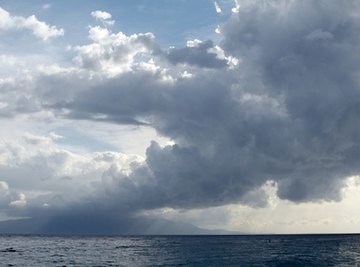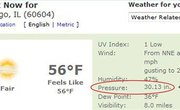
Air pressure is caused by the weight of air above an area pressing on surfaces below. It is measured in two ways: absolute barometric pressure and relative barometric pressure. Absolute barometric pressure uses the vacuum of space as its standard. Relative barometric pressure is measured relative to air pressure at sea level.
Barometric Pressure
Barometric pressure is a measure of the weight of the column of air above a specific point. Air isn't usually thought of as having weight, but the atmosphere is many miles thick and the gases that make it up are not weightless. The higher gases weigh down on the lower gases and everything they surround. This pressure compresses the air, which in turn presses on objects surrounded by air. This is air pressure. The amount of pressure it places on objects is measured as barometric pressure.
Absolute Pressure
Absolute barometric pressure is a comparison of how much pressure is exerted by the atmosphere compared to a vacuum, a space where there are no gases at all. The air pressure in a vacuum would be zero, since there are no gases to exert pressure on objects. Absolute barometric pressure is used primarily in scientific studies and industrial applications requiring precise data. Measurements known as "corrected barometric pressure" are used in most other applications, like weather reports.
Relative Pressure
Relative air pressure is known as corrected barometric pressure. It is a measurement of how much pressure an air column would exert at sea level. To determine corrected barometric pressure, an absolute air pressure measurement is taken, along with an altitude measurement. The relative air pressure of that column is the amount of air pressure it would exert at sea level, if it remained at a constant pressure all the way down. It is sometimes called relative pressure because it reports pressures relative to sea level.
Barometers
The barometer is the tool most often used to measure air pressure. Barometers are glass tubes sealed at the top but open on the bottom, where the bottom has been placed in a pool of mercury, which is open to the air. When the air pressure acting on the mercury is higher than the air pressure inside the glass tube, the mercury begins to move up the tube like a straw. Markings on the side of the glass tube allow for fairly precise measurements of air pressure.
Electric Pressure Transducers

A more modern tool for reading air pressure is the electronic pressure transducer. Its main components are a silicon wafer and a metal diaphragm. The metal diaphragm is used to seal a tube of air. The silicon wafer is bonded to one surface of the metal diaphragm. When air exerts pressure on the diaphragm, the diaphragm bends, along with the silicon wafer. The change in shape of the silicon wafer changes its electrical properties, which are monitored by an electric circuit. The changes in the electrical current through the wafer are converted to a pressure reading.
References
About the Author
Leighton Sawatzky began his writing career in 2008 as a writer and editor for the research magazine "Conscientia." After earning his Bachelor of Arts in communications, he went on to earn a Master of Arts in philosophy at Trinity Western University.
Photo Credits
cloud 1 image by Przemyslaw Koroza from Fotolia.com
